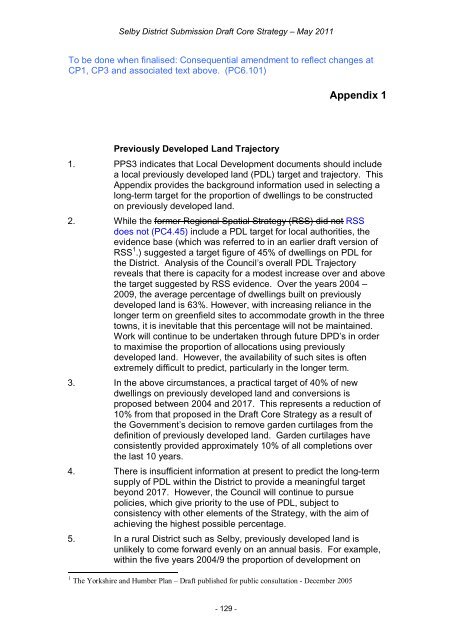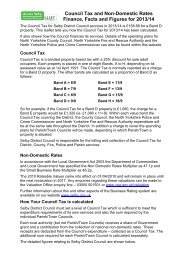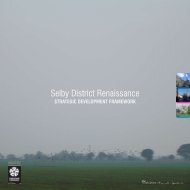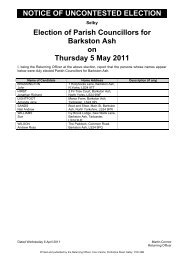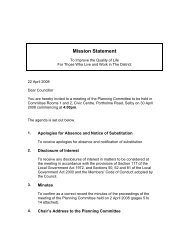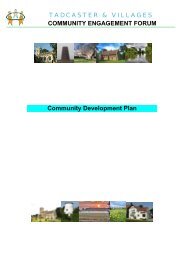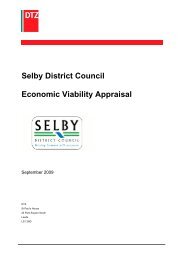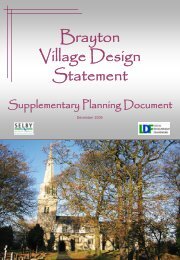Tracked Version of Core Strategy, November 2012 - Selby District ...
Tracked Version of Core Strategy, November 2012 - Selby District ...
Tracked Version of Core Strategy, November 2012 - Selby District ...
You also want an ePaper? Increase the reach of your titles
YUMPU automatically turns print PDFs into web optimized ePapers that Google loves.
<strong>Selby</strong> <strong>District</strong> Submission Draft <strong>Core</strong> <strong>Strategy</strong> – May 2011<br />
To be done when finalised: Consequential amendment to reflect changes at<br />
CP1, CP3 and associated text above. (PC6.101)<br />
Appendix 1<br />
Previously Developed Land Trajectory<br />
1. PPS3 indicates that Local Development documents should include<br />
a local previously developed land (PDL) target and trajectory. This<br />
Appendix provides the background information used in selecting a<br />
long-term target for the proportion <strong>of</strong> dwellings to be constructed<br />
on previously developed land.<br />
2. While the former Regional Spatial <strong>Strategy</strong> (RSS) did not RSS<br />
does not (PC4.45) include a PDL target for local authorities, the<br />
evidence base (which was referred to in an earlier draft version <strong>of</strong><br />
RSS 1 .) suggested a target figure <strong>of</strong> 45% <strong>of</strong> dwellings on PDL for<br />
the <strong>District</strong>. Analysis <strong>of</strong> the Council’s overall PDL Trajectory<br />
reveals that there is capacity for a modest increase over and above<br />
the target suggested by RSS evidence. Over the years 2004 –<br />
2009, the average percentage <strong>of</strong> dwellings built on previously<br />
developed land is 63%. However, with increasing reliance in the<br />
longer term on greenfield sites to accommodate growth in the three<br />
towns, it is inevitable that this percentage will not be maintained.<br />
Work will continue to be undertaken through future DPD’s in order<br />
to maximise the proportion <strong>of</strong> allocations using previously<br />
developed land. However, the availability <strong>of</strong> such sites is <strong>of</strong>ten<br />
extremely difficult to predict, particularly in the longer term.<br />
3. In the above circumstances, a practical target <strong>of</strong> 40% <strong>of</strong> new<br />
dwellings on previously developed land and conversions is<br />
proposed between 2004 and 2017. This represents a reduction <strong>of</strong><br />
10% from that proposed in the Draft <strong>Core</strong> <strong>Strategy</strong> as a result <strong>of</strong><br />
the Government’s decision to remove garden curtilages from the<br />
definition <strong>of</strong> previously developed land. Garden curtilages have<br />
consistently provided approximately 10% <strong>of</strong> all completions over<br />
the last 10 years.<br />
4. There is insufficient information at present to predict the long-term<br />
supply <strong>of</strong> PDL within the <strong>District</strong> to provide a meaningful target<br />
beyond 2017. However, the Council will continue to pursue<br />
policies, which give priority to the use <strong>of</strong> PDL, subject to<br />
consistency with other elements <strong>of</strong> the <strong>Strategy</strong>, with the aim <strong>of</strong><br />
achieving the highest possible percentage.<br />
5. In a rural <strong>District</strong> such as <strong>Selby</strong>, previously developed land is<br />
unlikely to come forward evenly on an annual basis. For example,<br />
within the five years 2004/9 the proportion <strong>of</strong> development on<br />
1 The Yorkshire and Humber Plan – Draft published for public consultation - December 2005<br />
- 129 -


